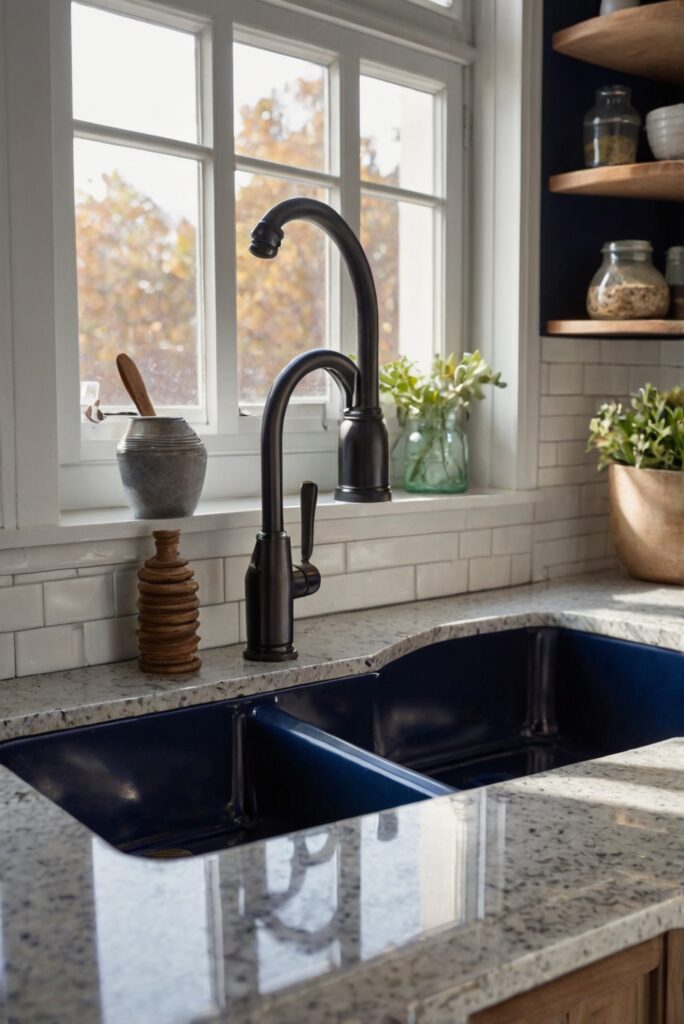Explore the key factors to consider when selecting the optimal drain placement for your kitchen sink. Enhance your daily interior designer routine with this essential design detail.
How to Choose the Right Drain Placement for Your Kitchen Sink?
As part of your daily home decor routine, it is crucial to consider the drain placement when designing your kitchen sink area. Proper drain placement can enhance the functionality and aesthetics of your kitchen space. When choosing the right drain placement for your kitchen sink, consider factors such as plumbing restrictions, space planning, and accessibility. Ensure that the drain is positioned efficiently to prevent clogging and promote efficient water drainage. By paying attention to these details, you can create a well-organized and visually appealing kitchen. Additionally, consult with interior designers or kitchen design experts for professional advice on optimal drain placement.
– Focused Kitchen Designs
– Efficient Water Drainage
– Plumbing Considerations
– Consult with Interior Designers
Consider the Layout of Your Kitchen:
When choosing the right drain placement for your kitchen sink, it is essential to consider the layout of your kitchen. The location of your sink in relation to other appliances, cabinets, and countertops will play a significant role in determining the ideal drain placement. Make sure the drain is easily accessible and does not obstruct any nearby fixtures or appliances.
Think About Your Cooking and Cleaning Habits:
Your cooking and cleaning habits can also influence the best drain placement for your kitchen sink. If you do a lot of cooking and cleaning in your sink, you may want to consider a drain placement that allows for easy access and efficient water drainage. Think about how you use your sink on a daily basis and choose a drain placement that complements your habits.
Consult with a Professional:
If you are unsure about the best drain placement for your kitchen sink, it may be helpful to consult with a professional. A plumber or kitchen designer can provide valuable insights and recommendations based on your specific kitchen layout and needs. They can help you choose a drain placement that maximizes functionality and efficiency.
Consider the Size and Shape of Your Sink:
When selecting the drain placement for your kitchen sink, consider the size and shape of the sink itself. The drain should be positioned in a way that allows for optimal water drainage and prevents any pooling or standing water. Take into account the dimensions of your sink when determining the ideal drain placement.
Evaluate the Plumbing Configuration:
Another important factor to consider when choosing the right drain placement for your kitchen sink is the plumbing configuration. The location of existing plumbing lines and connections will impact where the drain can be positioned. It is essential to work within the constraints of your plumbing system to ensure proper installation and functionality.
In conclusion, when selecting the right drain placement for your kitchen sink, it is crucial to consider various factors such as the layout of your kitchen, your cooking and cleaning habits, and the size and shape of your sink. Consulting with a professional and evaluating the plumbing configuration can also help guide your decision-making process. By taking these factors into account, you can choose a drain placement that enhances the functionality and efficiency of your kitchen sink.
What is the importance of choosing the right drain placement for your kitchen sink?
Choosing the right drain placement for your kitchen sink is crucial as it directly impacts the functionality and usability of your sink. The drain placement determines how efficiently water and food debris are drained, preventing clogs and ensuring proper drainage. It also affects the overall aesthetics and design of your kitchen, as the drain placement can influence the layout and flow of the space.
What factors should you consider when choosing the drain placement for your kitchen sink?
When selecting the drain placement for your kitchen sink, important factors to consider include the size and shape of your sink, the location of existing plumbing lines, and the overall layout of your kitchen. Additionally, you should think about how you use your sink on a daily basis and whether a specific drain placement will enhance your workflow and convenience in the kitchen.
How can you determine the best drain placement for your kitchen sink?
To determine the best drain placement for your kitchen sink, start by assessing your needs and preferences. Think about whether you prefer a center drain, rear drain, or corner drain configuration. Consider consulting with a kitchen designer or plumber to get expert advice on the most suitable drain placement based on your kitchen layout and plumbing system.
What are some common drain placement options for kitchen sinks?
Some common drain placement options for kitchen sinks include center drains, rear drains, and corner drains. Center drains are typically located in the middle of the sink, while rear drains are positioned towards the back. Corner drains are situated in one of the corners of the sink. Each drain placement offers its own set of advantages and may be more suitable for certain kitchen layouts and preferences.
Are there any specific guidelines or tips to follow when choosing the drain placement for your kitchen sink?
When selecting the drain placement for your kitchen sink, it’s important to ensure that the drain aligns with your garbage disposal and dishwasher if you have them. Additionally, consider the cabinet space underneath the sink and how the drain placement will impact storage and access. It’s also recommended to test different configurations by using cardboard cutouts to visualize the best drain placement before installation.

